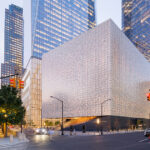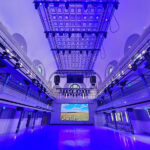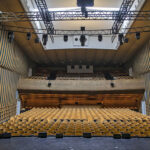The Club Reopens with a New DJ, Roof and Memorable Visual Experience
Known as one of the hottest nightclubs in Miami back in the early 1990s when owners Gregory and Andre Boudou introduced house and trance music, huge foam parties and a European, open-ceiling grotto style layout to South Florida partygoers, Amnesia has returned in 2011 with the Boudous joined by DJ Bob Sinclair.
Same Site, Owners
The site for Amnesia is the same, but a few things are different. There’s the new roof, for example, and air-conditioning. Along with the ability to put a cap on the noise ordinance violations that contributed to the club’s shutting down in 1995, the roof supports a sophisticated lighting, video, audio and rigging system engineered for the club by HMS Inc., a purveyor of technical services for the cruise ship industry’s entertainment needs. Since 1983, HMS has worked with Carnival, Holland America, Princess, Costa, Silversea, MSC Cunard, Celebrity, Radisson and Royal Caribean. Part of IEC since 2006, HMS is now actively involved in land projects ranging from European hotel re-fittings, TV studios and custom villas with specific entertainment needs.
A Memorable Project
The brief for Amnesia was for an “over the top” system delivering a uniquely memorable experience for the club’s guests. Michael Stone, HMS vice president of U.S. operations in Miami and Ludovic Leroy, director of project management, filled PLSN in on the details on the transformation of Club Amnesia’s 26,000 square feet of space. Those changes, from concept to final install, took place over the course of five months. There were 12 technicians working on the lighting system, four more for audio and three for the LED elements.
Key visual focal points start with the elevated DJ area and lighting tech booth, with VIP booths in the center of the club behind the main dance floor. There’s a large LED wall on a Tambè motorized track comprised of three Modul8-controlled screens, each measuring 2.5 by 3.5 meters. That video wall splits to reveal a secondary elevated stage with yet another large LED screen behind it; it measures 6 by 3 meters. Additional video content seen at the bars on 42-inch Samsung LED monitors are split into four video “zones,” with content governed by ArKaos MediaMaster.
Design Flexibility
Versatility and flexibility were key priorities with the venue’s structural setup. The stage behind the DJ can have a set piece added to extend the stage for a live band or model runway. The club was also engineered to quickly convert to support live bands with a patch for an FOH console and live audio crew. The heavy lifting is done by a rigging system that includes 23 Stagemaker hoists and six Motion Labs hoist controllers. HMS also provided the communications network infrastructure for the club.
The lighting rig for the main dance floor includes a 25-by-25-foot cross shape truss and five truss circles measuring 10 feet in diameter, all comprised of James Thomas Engineering GP12. Another 20-foot length of truss supports lighting above the DJ and lighting tech booth.
Advanced Lighting Rig
Lighting designer Maxime Moussier, who also serves as a lighting director for the club on a weekly bases, uses a grandMA 2 Light console to set up an impressive visual buildup for when DJ Bob Sinclair takes the stage. (The proximity of the lighting tech booth and DJ allows for quick interactions between Moussier and Sinclair.)
The lighting rig includes 43 Clay Paky Sharpy moving lights, 21 Martin MAC 301 fixtures and 30 Chauvet COLORado COLORdash battens set up in a diagonal pattern. To light the talent, and for palm trees and other architectural features, there 30 COLORado 2 Tours, eight COLORado 1 IPs and seven COLORado 3 IPs, with a Chauvet DFI DMX TX/RX for wireless control.
Thirty OXO Lighting T10 active blinders and five Solaris Quazar 15K strobe lights round out the rig, with two Look Solutions ORKA smoke machines and two Look Solutions UNIK 2.1 haze machines added for atmospheric effects.


